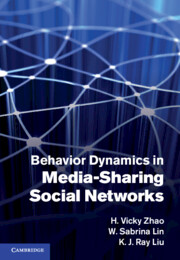Book contents
- Frontmatter
- Contents
- Preface
- Part I Introduction
- Part II Behavior forensics in media-sharing social networks
- Part III Fairness and cooperation stimulation
- Part IV Misbehaving user identification
- 11 Cheating behavior in colluder social networks
- 12 Attack resistance in peer-to-peer video streaming
- Part V Media-sharing social network structures
- References
- Index
12 - Attack resistance in peer-to-peer video streaming
from Part IV - Misbehaving user identification
Published online by Cambridge University Press: 28 April 2011
- Frontmatter
- Contents
- Preface
- Part I Introduction
- Part II Behavior forensics in media-sharing social networks
- Part III Fairness and cooperation stimulation
- Part IV Misbehaving user identification
- 11 Cheating behavior in colluder social networks
- 12 Attack resistance in peer-to-peer video streaming
- Part V Media-sharing social network structures
- References
- Index
Summary
Chapter 9 studies cooperation stimulation for P2P video streaming over Internet and wireless networks. One assumption there is that all users in the P2P networks are rational, and their goal is to maximize their own payoffs. As discussed in Chapter 9 and shown in Figure 12.1, they may lie to others about their personal information if they believe cheating can help increase their utilities. There might also exist malicious users who aim to exhaust others' resources and attack the system. For example, in P2P systems, they can tamper the media files with the intention of making the content useless (the so-called pollution attack). They can also launch the denial of service (DoS) attack to exhaust other users' resources and make the system unavailable. What is more, once an attacker is detected, he or she can leave the network temporarily, come back later with a new ID, and continue causing damage to the system.
To further proliferate P2P systems and provide reliable service, misbehavior detection and attack resistance are fundamental requirements to stimulate user cooperation even under attacks. A challenging issue in malicious user detection in P2P video streaming is to differentiate between “intentional” misbehavior (for example, intentional modification of the video content) and “innocent” ones (such as transmission error and packet loss in error-prone and congested networks).
In this chapter, we first model the P2P video streaming network over the Internet as a multiplayer game, which includes both rational (selfish) and malicious users.
- Type
- Chapter
- Information
- Behavior Dynamics in Media-Sharing Social Networks , pp. 247 - 274Publisher: Cambridge University PressPrint publication year: 2011



